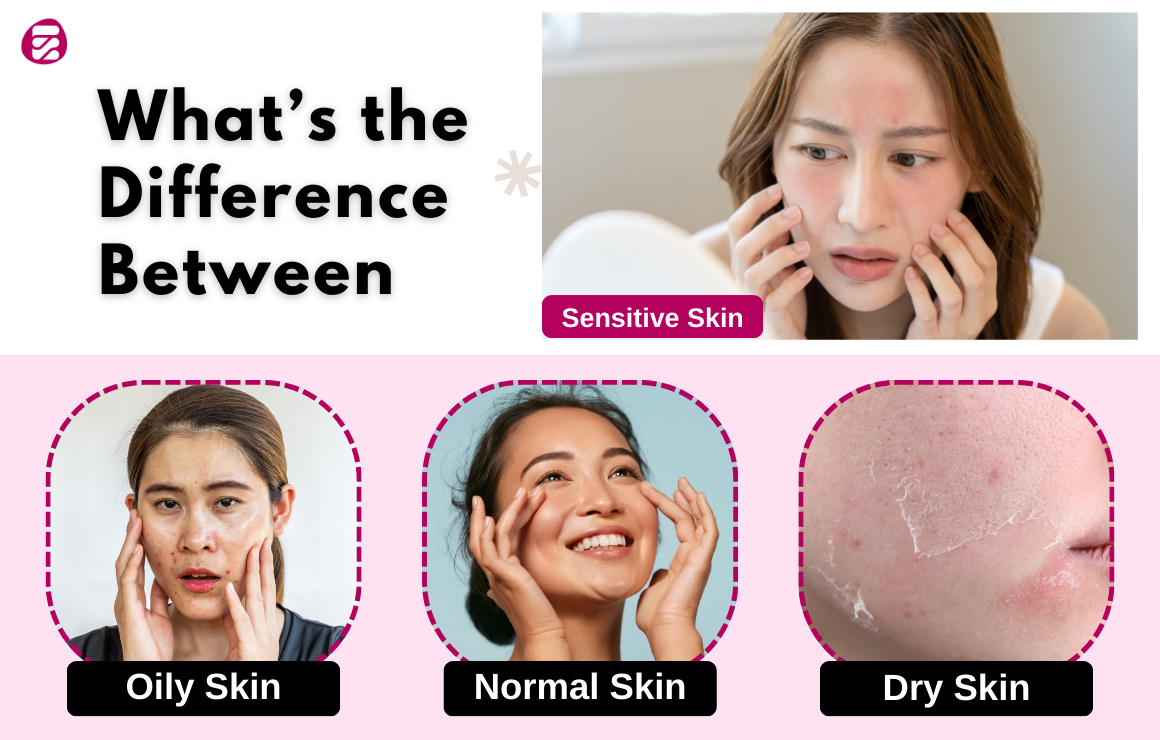When it comes to skincare, one of the most important first steps is identifying your skin type. Understanding your skin’s needs allows you to select the best products, avoid irritation, and achieve healthier, glowing skin. However, with so many terms—oily, dry, normal, sensitive, and combination skin—it can be confusing to determine where you fall. In this comprehensive guide, we’ll explain the differences between these common skin types, how to identify your own, and which skincare routines and products are most suitable for each.
1. Oily Skin
What is Oily Skin?
Oily skin is characterized by an overproduction of sebum (natural oils) from the sebaceous glands. This excess oil leads to a shiny complexion, particularly in the T-zone (forehead, nose, and chin), enlarged pores, and an increased risk of acne and blackheads.
How to Identify Oily Skin
- Shiny appearance, especially in the T-zone.
- Large, visible pores.
- Frequent breakouts, especially on the forehead, nose, and chin.
- Skin feels greasy a few hours after washing.
Skincare Tips for Oily Skin
- Cleanse regularly with a gentle foaming or gel-based cleanser to remove excess oil without drying out the skin.
- Use oil-free and non-comedogenic moisturizers and makeup products.
- Incorporate a mattifying primer to reduce shine throughout the day.
- Consider exfoliating a few times a week to help prevent clogged pores.
2. Normal Skin
What is Normal Skin?
Normal skin is often considered the “ideal” skin type. It’s balanced, neither too oily nor too dry, and has a healthy, smooth texture. People with normal skin usually experience fewer blemishes, blackheads, or dry patches.
How to Identify Normal Skin
- No excessive shine or dryness.
- Small to average-sized pores.
- Even skin tone and texture with minimal breakouts.
- Comfortable feeling after cleansing (neither tight nor greasy).
Skincare Tips for Normal Skin
- Continue a basic skincare routine, using gentle cleansers and light moisturizers.
- Incorporate an antioxidant serum or moisturizer with ingredients like vitamin C to keep the skin healthy and protected.
- Consider gentle exfoliation 1-2 times a week to maintain smooth skin texture.
3. Dry Skin
What is Dry Skin?
Dry skin occurs when your skin fails to produce enough sebum, leading to a lack of moisture and hydration. People with dry skin often struggle with tightness, rough patches, and an overall dull appearance. It can be more prone to flaking, redness, and irritation.
How to Identify Dry Skin
- Skin feels tight, especially after cleansing.
- Flaky, rough patches or visible dryness.
- Redness or irritation may occur.
- Pores are less noticeable due to reduced oil production.
- Fine lines or wrinkles may be more visible.
Skincare Tips for Dry Skin
- Use a creamy or hydrating cleanser that doesn’t strip natural oils.
- Opt for rich moisturizers containing humectants like hyaluronic acid or glycerin to draw moisture into the skin.
- Incorporate a hydrating mask or serum with nourishing ingredients like ceramides or squalane.
- Avoid hot water when washing your face, as it can further dry out your skin.
- Consider using a humidifier at night to keep moisture levels in the air balanced.
4. Sensitive Skin
What is Sensitive Skin?
Sensitive skin is easily irritated by environmental factors, skincare products, or even weather changes. It may react to certain ingredients, causing redness, itching, burning sensations, or rashes. Sensitive skin can also occur alongside other skin types, like oily or dry skin.
How to Identify Sensitive Skin
- Skin reacts negatively to new products (redness, burning, or stinging).
- You experience frequent irritation or allergic reactions.
- Skin feels itchy or inflamed after exposure to environmental triggers.
- Prone to conditions like rosacea or eczema.
Skincare Tips for Sensitive Skin
- Stick to fragrance-free and hypoallergenic skincare products.
- Look for soothing ingredients like aloe vera, chamomile, or niacinamide.
- Use a gentle, hydrating cleanser and avoid exfoliating scrubs that can be too harsh.
- Avoid hot showers and minimize sun exposure.
- Consider using patch testing before introducing new products into your routine to prevent reactions.
5. Combination Skin
What is Combination Skin?
Combination skin is a mix of different skin types. Typically, people with combination skin experience an oily T-zone (forehead, nose, and chin) while the cheeks and other areas of the face are normal or dry. This skin type is often the trickiest to manage because it requires balancing both oil control and hydration.
How to Identify Combination Skin
- Oily T-zone with dry or normal cheeks.
- Prone to breakouts in the T-zone but dry patches on other areas.
- Different textures in different areas of the face.
- Pores appear larger in the T-zone, while other areas feel drier.
Skincare Tips for Combination Skin
- Use a gentle foaming cleanser for oily areas, and a hydrating cleanser for dry zones.
- Apply a light, oil-free moisturizer to balance hydration without clogging pores.
- Target treatments: use mattifying products on the T-zone, and richer creams or serums on the cheeks.
- Consider a toner to help balance the skin’s oil production without drying it out.



Add comment